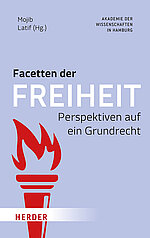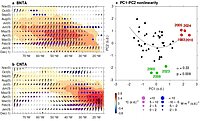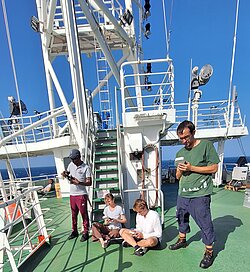Meldungsarchiv
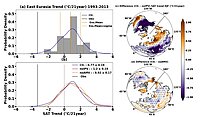
The Probability Density Function of the DJF-surface air temperature (SAT) trend for the period 1993–2014, averaged over the region between 60°E–120°E and 45°N–60°N (box shown in Figure 3). (a) Control ensemble (Ctl), the gray bars represent the estimates from the individual members, the blue line is the fitted distribution based on kernel density estimation, and the solid black line depicts the ERA5-SAT trend. The ensemble mean of the Ctl ensemble is indicated by the solid orange line, with the orange dashed lines representing the ±standard deviation (sigma). (b), Fitted Probability Density Functions from the Ctl and the noIPV and noAMV ensembles. The numbers in the legend are the ensemble mean and standard deviation obtained by applying a bootstrapping method. Panels (c, d) show the ensemble mean difference between Ctl and noIPV and noAMV, respectively. Dots indicate statistically significance at the 95% confidence level.
- September 2025:
Neue Veröffentlichung:Savita, A., Kjellsson, J., Latif, M., Nnamchi, H. C., & Wahl, S. (2025). Causes of Eurasian winter-cooling during the late 20th and early 21st century. Geophysical Research Letters, 52, e2024GL114140. https://doi.org/10.1029/2024GL114140
Summary:
Using atmospheric-model experiments, we find that intrinsic atmospheric variability is the main driver of the recent pronounced wintertime surface cooling over Eurasia during 1993–2013. More specifically, the leading mode of atmospheric circulation variability over the Atlantic sector known as the North Atlantic Oscillation (NAO) was responsible for the largest portion of the Eurasian cooling. The sea-surface temperature (SST) of the Pacific Ocean also contributed to the cooling, but to a lesser degree than the NAO, whereas the North Atlantic SST had only a modest influence. This study suggests that decadal predictability of Eurasian surface climate could be limited.
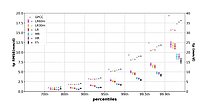
European averaged precipitation amounts and RMSEs (referenced to GPCC) for European total precipitation at different percentile ranges (70th–80th, 80th–90th, 90th–95th, 95th–99th, 99th–99.5th, 99.5th–99.9th, and > 99.9th percentile) in ERA5 (black) and OpenIFS simulations (LR60m: magenta, LR30m: orange, LR: red, MR: blue, HR: purple) during 1982–2019. Cross marks are the precipitation amounts. Dots are the RMSE values, and error bars are the 95 % CI.
- September 2025:
Neue Veröffentlichung:Liu, Y., Kjellsson, J., Savita, A., and Park, W.: Impact of horizontal resolution and model time step on European precipitation extremes in the OpenIFS 43r3 atmospheric model, Geosci. Model Dev., 18, 5435–5449, https://doi.org/10.5194/gmd-18-5435-2025, 2025
Abstract:
Events of extreme precipitation pose a hazard to many parts of Europe but are typically not well represented in climate models. Here, we evaluate daily extreme precipita- tion over Europe during 1982–2019 in observations (GPCC), reanalysis (ERA5), and a set of atmosphere-only simulations at low (100 km), medium (50 km), and high (25 km) horizon- tal resolution and also at different time steps (i.e., 60, 30, and 15 min) using low resolution (100 km) with identical verti- cal resolutions using OpenIFS (version 43r3). We find that both OpenIFS simulations and reanalysis underestimate the rates of extreme precipitation compared to observations. The biases are largest for the lowest resolution (100 km) and de- crease with higher-horizontal-resolution (50 and 25 km) sim- ulations in all seasons. The sensitivity to horizontal resolu- tion is particularly high in mountain regions (such as the Alps, Scandinavia, Iberian Peninsula), likely linked to the sensitivity of vertical velocity to the representation of to- pography. The sensitivity of precipitation to model resolu- tion increases dramatically with increasing percentiles, with modest biases in the 70th–80th percentile range and large bi- ases above the 99th percentile range. We also find that pre- cipitation above the 99th percentile mostly consists of large- scale precipitation (∼ 80 %) in winter, while in summer it is mostly large-scale precipitation in northern Europe (∼ 70 %) and convective precipitation in southern Europe (∼70%). Convective precipitation is more sensitive to model time step than to horizontal resolution. Large-scale precipitation in- creases significantly with both higher horizontal resolution and a shorter model time step.

Summary results for global mean surface temperature (GMST) response in the trial flat10MIP. Colored lines indicate temperature change from (a) pre-industrial levels to (b, c) T100 yr (the average temperature in years 91–110 in esm-flat10) in each of the participating ESMs. Shaded regions refer to the simple climate models' probabilistic distribution ranging from the 10th to 90th percentiles. This distribution is shown as violin plots for the last time step of each scenario, where the shading shows the full range of results and the vertical line indicates the 10th–90th percentiles, with the median in the center. A 20-year moving average is applied to all time series.
- September 2025:
Neue Veröffentlichung:Sanderson, B. M., Brovkin, V., Fisher, R. A., Hohn, D., Ilyina, T., Jones, C. D., Koenigk, T., Koven, C., Li, H., Lawrence, D. M., Lawrence, P., Liddicoat, S., MacDougall, A. H., Mengis, N., Nicholls, Z., O'Rourke, E., Romanou, A., Sandstad, M., Schwinger, J., Séférian, R., Sentman, L. T., Simpson, I. R., Smith, C., Steinert, N. J., Swann, A. L. S., Tjiputra, J., and Ziehn, T.: flat10MIP: an emissions-driven experiment to diagnose the climate response to positive, zero and negative CO2 emissions, Geosci. Model Dev., 18, 5699–5724, https://doi.org/10.5194/gmd-18-5699-2025, 2025.
Short Summary:
This study investigates how climate models warm in response to simplified carbon emissions trajectories, refining the understanding of climate reversibility and commitment. Metrics are defined for warming response to cumulative emissions and for the cessation of emissions or ramp-down to net-zero and net-negative levels. Results indicate that previous concentration-driven experiments may have overstated the Zero Emissions Commitment due to emissions rates exceeding historical levels.
- September 2025:
Mündliche Prüfung der Doktorarbeit von Estela MonteiroSummary:
Over the past century, human activities have caused strong alterations to the climate system. Such changes have been confidently attributed to human activities, and international political efforts have attempted to avoid further impacts by limiting global warming levels. In this sense, highly ambitious emissions mitigation scenarios are a desirable future to be aimed for, with a current need for a rapid political and societal move towards such. Despite a clear benefit, and necessity, of reaching such scenarios, uncertainty remains regarding potential system responses as the importance of carbon forcing decreases. Even if these uncertainties should not halt decision-making towards such kinds of future scenarios, a better understanding of the expected responses will allow society to properly assess needed and possible outcomes from our current, and past, decisions.
A first result of this thesis shows that varying aerosols spatial implementation in an intermediate complexity model allows for a considerable surface temperature variability, as well as variability in individual components’, such as land carbon uptake and ocean heat uptake, contributions to the warming or cooling of the system. Triggered feedbacks due to aerosols implementations can have a crucial impact in assessing highly ambitious mitigation scenarios, and should be accounted for by the tools used to study such scenarios.
Furthermore, the presentation introduced the use of a new framework (FROT: Framework for Radiative cOntributions to Temperature responses), to comprehensively assess the temperature variability simulated by distinct models for different ambitious mitigation future scenarios, and to account for individual contributions from different climate components. The findings corroborate the need for including forcings and transient responses when assessing climate development, and show that different sets of climate contributions allow for temperature stabilisation.
Finally, the work here has focused on techniques with the potential to remove carbon dioxide from the atmosphere. It found that for centennial timescales dissolved ocean oxygen, in terms of its total global content, is unable to return to pre-industrial levels. This response, however, is highly dependent on the region and depth considered. While oxygen solubility appears to play a role in controlling the responses in the upper ocean, the findings indicate that apparent oxygen use dominates the simulated oxygen development, especially related to changes in circulation and ventilation.
The reported findings widen the understanding of the range of expected responses and components development under highly ambitious emissions mitigation scenarios, either by reducing or by clarifying different uncertainties expected in the assessment, analysis and potential real-world outcomes of these scenarios. The conclusions here can provide meaningful information to not only improve science understanding, but also inform political and societal decision-making processes.
- September 2025:
Neue Veröffentlichung:Mojib Latif (Hg). 2025: Facetten der Freiheit - Perspektiven auf ein Grundrecht. Herder Verlag, 240 S
Die vielen Gesichter der Freiheit
Bedroht der Klimawandel die Freiheit? Was bedeuten freie Märkte für den Menschen? Ist das geeinte Europa ein Hort der Freiheit? Macht uns die Künstliche Intelligenz wirklich frei? Wie frei sind Gedanken in totalitären Systemen? Und lässt sich Freiheit überhaupt messen? Diesen und anderen Fragen gehen renommierte Forscherinnen und Forscher aus Natur- und Geisteswissenschaften im neuen Band der Essay-Reihe der Akademie der Wissenschaften in Hamburg nach. Sie zeigen: Der Begriff der Freiheit birgt viele Dimensionen.
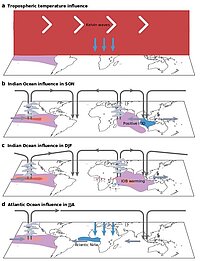
Mechanisms of impact of the El Niño–Southern Oscillation (ENSO) on African climate
a, Schematic representation of the tropospheric temperature mechanism, whereby El Niño triggers a Gill–Matsuno response, the atmospheric Kelvin waves (eastward arrows) of which increase atmospheric stability outside the Pacific, suppressing atmospheric convection (and thereby reducing rainfall) over the Sahel (blue downward arrows). b, Schematic representation of the Indian Ocean influence in September–October–November (SON), wherein El Niño weakens the Walker circulation (grey arrows), leading to a positive Indian Ocean Dipole (IOD) that enhances short rains in East Africa through increasing convergence toward East Africa. c, As in panel b, but during December–January–February (DJF) when El Niño-related Walker circulation weakening causes Indian Ocean Basin mode (IOB) warming that reduces the land–ocean pressure gradient, and lowers the southward extension of seasonal flow convergence and the equatorward shift of the South Indian Convergence Zone equatorward compared with the climatology (light versus dark arrows), in turn, increasing rainfall in northeast southern Africa but decreasing it in southeast southern Africa. d, Schematic representation of the Atlantic Ocean influence in June–July–August (JJA), whereby El Niño-related weakening of the Walker circulation drives development of an Atlantic Niña that shifts the tropical rain belt northward, decreasing rainfall over the Guinea coast but increasing rainfall over the Sahel; this increased Sahel rainfall competes with rainfall reductions via the tropospheric temperature mechanism in panel a. Thus, El Niño influences African climate through troposphere temperature warming and concurrent modes of variability in the Indian Ocean and the Atlantic oceans.
- August 2025:
Neue Veröffentlichung:Cai, W., C. Reason, E. Mohino, B. Rodríguez de Fonseca, J. Malherbe, A. Santoso, X. Li,
H. Chikoore, H. C. Nnamchi, M. J. McPhaden, N. Keenlyside, A. Taschetto, L. Wu, B.
Ng, Y. Liu, T. Geng, K. Yang, G. Wang, F. Jia, X. Lin, S. Li, Y. Yan, J. Wang, L. Zhang,
Z. Li, W. Pokam, L Zhou, X. Zhang, F. Engelbrecht (2025). Impact of El Niño-Southern
Oscillation on African climate. Nature Reviews Earth & Environment. 6, 503520.
https://doi.org/10.1038/s43017-025-00705-7.Abstract:
The El Niño–Southern Oscillation (ENSO) — describing shifts between warm El Niño and cold La Niña phases — has a substantial effect on the global climate. In this Review, we outline the mechanisms and climate impacts of ENSO in Africa, focusing on rainfall. ENSO’s influence varies strongly by season, region, phase, event and decade, highlighting complex dynamics and asymmetries. Although difficult to generalize, key characteristics include: anomalies across the Sahel in July–September, related to the tropospheric temperature mechanism; a strong dipole in anomalies between eastern and southern Africa during October–December (the short rain reason) and December–February, linked to interactions with the Indian Ocean Dipole and Indian Ocean Basin mode, respectively; and anomalies over southern Africa (with possible indications of opposite anomalies over East Africa) during March–May (the long rain season), associated with continuation of the Indian Ocean Basin mode. These teleconnections tend to be most pronounced for East Pacific El Niño and Central Pacific La Niña events, as well as during decades when interbasin interactions are strongest. Although challenging to simulate, climate models suggest that these impacts will strengthen in the future, manifesting as an increased frequency of ENSO-related dry and wet extremes. Given the reliance of much of Africa on rain-fed agriculture, resolving these relationships is vital, necessitating realistic simulation of regional circulations, ENSO and its interbasin interactions.
- Juli 2025:
Neue Veröffentlichung:
Liu, Y., M. J. McPhaden, W. Cai, Y. Zhang, J. Zhao, H. C. Nnamchi, X. Lin, Z. Li, J-.Y. Yang (2025). Basin-wide and coastal modes of north tropical Atlantic variability have distinct impacts onhurricanes. Communications Earth & Environment. 6, 549. doi.org/10.1038/s43247-025-02529-1.Abstract:
Warm sea surface temperature anomalies in the north tropical Atlantic are conducive to increased intensity and frequency of Atlantic hurricanes. The period 2023-2024 saw two consecutive warm events but with distinct anomaly patterns. Here we use observations and model outputs over the past several decades to determine whether there exists inherent diversity in north tropical Atlantic surface temperature spatial structures and impacts. We find two distinctive modes of variability: a basin-wide mode and a coastal mode, underpinned by differing relationships between air-sea heat flux and sea surface temperature anomalies. The basin-wide mode has a stronger influence on Atlantic hurricane activity due to its more westward and persistent anomaly pattern. Since the 1990s, the well-known impact from El Niño-Southern Oscillation on the north tropical Atlantic is felt through its influence on the basin-wide mode. Our results highlight the importance of distinguishing the two distinctive modes in assessing and predicting their impacts.
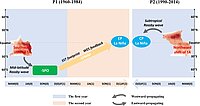
Schematic diagram illustrating the physical mechanisms driving the changes in the tropical Atlantic (TA)−El Niño-Southern Oscillation (ENSO) relationship.
During 1960–1984 (P1), when spring-to-summer TA mode moves southward, the South Tropical Atlantic (STA) warming can force South Pacific Oscillation (SPO)-like atmospheric circulation anomalies by an eastward-propagating Mid-latitude Rossby wave, which can then induce a South Pacific Meridional Mode (SPMM)-like sea surface temperature (SST) footprint during the winter of the first year. The SPMM interacts with the trade winds and extends negative SST anomalies equatorward into the equatorial Pacific through the wind–evaporation–SST (WES) feedback, leading to an eastern Pacific (EP)-type La Niña event over the equatorial Pacific during the winter of the second year. During 1990–2014 (P2), when spring-to-summer TA mode moves northward, the North Tropical Atlantic (NTA) warming can quickly initiate a central Pacific (CP)-type La Niña event through a westward-propagating subtropical Rossby wave during the winter of the first year.
- Juli 2025:
Neue Veröffentlichung:Tian, Q., J.-Y. Yu, H. C. Nnamchi, T. Li, J. Li, L. Zhang, X. Li (2025). Unraveling the mystery of recent shortened response time of ENSO to Atlantic forcing. Nature Communications. 16, 5884. https://doi.org/10.1038/s41467-025-61130-4
Abstract:
The El Niño-Southern Oscillation (ENSO) is known to respond to tropical Atlantic (TA) sea surface temperature (SST) forcing. However, the response time of ENSO to the TA SST forcing is not stationary but varies over decades, the reasons for which remain poorly understood. Here we show that decadal changes in ENSO’s response time to TA SST forcing are primarily influenced by the south-north shift of the dominant mode of TA SST variability itself. Before the mid-1980s, the southward-shifted TA mode prolongs the response time to ~20 months through an eastward-propagating mid-latitude teleconnection. In contrast, when the TA mode shifts northward after the mid-1980s, the response time decreases to 6–9 months via a faster westward-propagating subtropical teleconnection. Our findings underscore the importance of considering the meridional shift of the TA mode when understanding the impacts of the TA SST variability on ENSO, which has profound implications for ENSO forecasting.
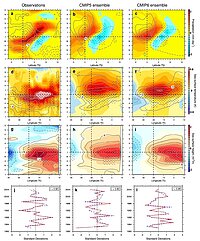
The leading zonal-meridional coupled variability mode in the equatorial Atlantic 1982–2004.
a–c Meridional precipitation anomalies regressed on the SST-PC1 (color-scale), the contours show the SST anomalies regressed on the precipitation-PC1; d–f Zonal-SST anomalies regressed on the precipitation-PC1 (color-scale), the contours show the precipitation anomalies regressed on the SST-PC1; g–i Zonal SSH anomalies regressed on the precipitation-PC1 (color-scale), the contours show the SSH anomalies regressed on the SST-PC1. j–l Normalized precipitation-PC1 (dashed, blue) and SST-PC1 (solid, red). Left–right columns: observations, CMIP5, and CMIP6 ensembles, respectively. In panels a–i, the stipples denote statistical significance at the 95% confidence level; the contour intervals are 0.1 K for SST, 0.3 mm/day for precipitation, and 10-2 m for the SSH anomalies.
- April 2025:
Neue Veröffentlichung:
Nnamchi, H.C., Latif, M. Predictable equatorial Atlantic variability from atmospheric convection-ocean coupling. npj Clim Atmos Sci 8, 149 (2025). https://doi.org/10.1038/s41612-025-01041-9Abstract:
The Atlantic Niño exerts profound impacts on regional and global atmospheric circulation and climate, and on equatorial Atlantic biogeochemistry and ecosystems. However, the mode’s prediction remains a challenge which has been partly attributed to weak atmosphere-ocean coupling in the region. Here we introduce a framework that enhances the detection of the coupling between meridional migrations of atmospheric deep convection and zonal thermocline feedback. This approach reveals high predictive skill in a 196-member seasonal prediction ensemble, demonstrating robust predictability at 1–5-month forecast initialization lead times. The coupled mode is strongly correlated with land-precipitation variability across the tropics. The predictive skill largely originates in the Atlantic Ocean and is uncorrelated with El Niño Southern Oscillation in the Pacific, the leading mode of interannual climate variability globally. These skillful predictions raise hopes for enabled action in advance to avoid the most severe societal impacts in the affected countries.
- April 2025:
Neue Veröffentlichung:Christian Baatz, Lukas Tank, Lena-Katharina Bednarz, Miranda Boettcher, Teresa Maria Morganti, Lieske Voget- Kleschin, Tony Cabus, Erik van Doorn, Tabea Dorndorf, Felix Havermann, Wanda Holzhüter, David Peter Keller, Matthias Kreuzburg, Nele Matz-Lück, Nadine Mengis, Christine Merk, Yiannis Moustakis, Julia Pongratz, Hendrikje Wehnert, Wanxuan Yao and Gregor Rehder (2025): "A holistic assessment framework for marine carbon dioxide removal options." Environmental Research Letters, DOI: 10.1088/1748-9326/adc93f
Abstract:
Marine Carbon Dioxide Removal (mCDR) options could potentially play an important role in future CDR policy portfolios. They include, for example, ocean alkalinity enhancement, blue carbon projects such as mangrove cultivation, as well as sub-seabed storage of captured atmospheric CO2. We present a novel assessment framework designed for mCDR options. The framework provides important conceptual advancements to existing frameworks currently used to assess climate options: It clearly distinguishes between and allows for the assessment of both the feasibility and desirability of mCDR options, it makes explicit the evaluative standards upon which the assessment is based and it separates the descriptive listing of information from the evaluation of said information. The assessment framework aims to advance the debate on what role mCDR can and should play in responding to the climate crisis by providing a tool for both policymakers and stakeholders to assess mCDR options in a transparent and comprehensive way.
- April 2025:
Neue Veröffentlichung:Tank, L., Voget-Kleschin, L., Garschagen, M., Boettcher, M., Mengis, N., Holland-Cunz, A., Rehder, G., and Baatz, C. (2025) "Distinguish between feasibility and desirability when assessing climate response options." npj Climate Action 4, 34. https://doi.org/10.1038/s44168-025-00237-2
Abstract:
The current literature on assessing climate change response options does not sufficiently distinguish between assessing options in terms of their feasibility and in terms of their desirability. One example of this is the IPCC feasibility assessment framework. We argue that assessments of climate response options should indeed cover questions of desirability, but they should do so explicitly. Transparency about underlying normative standards is the key to a productive desirability assessment.
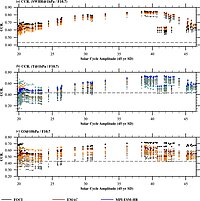
Initial 11-year solar cycle signals in the upper and middle stratosphere vs. the solar cycle amplitude. (a) Scatter plot of correlation coefficients between the annual shortwave heating rate anomalies in the tropical stratopause (averaged over 25° S–25° N at 1 hPa) and the annual F10.7 index in all 45-year running windows vs. the solar cycle amplitude (standard deviations of the annual F10.7 index in all 45-year windows) for FOCI (ensemble mean: black; light gray: individual members) and EMAC (brown: ensemble mean; light brown: individual members) in the FULL experiment. The dashed black line indicates the 95 % significance level. Panel (b) is the same as (a) but for the temperature anomalies at 1 hPa from FOCI, EMAC, and MPI-ESM-HR (blue: ensemble mean; light blue: individual members). Panel (c) is the same as (a) but for the O3 volume mixing ratio anomalies at 10 hPa from FOCI and EMAC.
- März 2025:
Neue Veröffentlichung:
Huo, W., Spiegl, T., Wahl, S., Matthes, K., Langematz, U., Pohlmann, H., Kröger, J. (2025) "Assessment of the 11-year solar cycle signals in the middle atmosphere during boreal winter with multiple-model ensemble simulations." Atmospheric Chemistry and Physics, 25 (4), 2589–2612, https://doi.org/10.5194/acp-25-2589-2025Summary:
To better understand possible reasons for the diverse modeling results and large discrepancies of the detected solar fingerprints, we took one step back and assessed the “initial” solar signals in the middle atmosphere based on a set of ensemble historical simulations with multiple climate models – the Flexible Ocean Climate Infrastructure (FOCI), the ECHAM/MESSy Atmospheric Chemistry (EMAC), and the Max Planck Institute for Meteorology Earth System Model in high-resolution configuration (MPI-ESM-HR). Consistent with previous work, we find that the 11-year solar cycle signals in the shortwave heating rate (SWHR) and ozone anomalies are robust and statistically significant in all three models. These initial solar cycle signals in the SWHR, ozone, and temperature anomalies are sensitive to the strength of the solar forcing. Correlation coefficients of the solar cycle with the SWHR, ozone, and temperature anomalies linearly increase along with the enhancement of the solar cycle amplitude. This reliance becomes more complex when the solar cycle amplitude – indicated by the standard deviation of the December–January–February mean F10.7 – is larger than 40. In addition, the cold bias in the tropical stratopause of EMAC dampens the subsequent results of the initial solar signal. The warm pole bias in MPI-ESM-HR leads to a weak polar night jet (PNJ), which may limit the top-down propagation of the initial solar signal. Although FOCI simulated a so-called top-down response as revealed in previous studies in a period with large solar cycle amplitudes, its warm bias in the tropical upper stratosphere results in a positive bias in PNJ and can lead to a “reversed” response in some extreme cases. We suggest a careful interpretation of the single model result and further re-examination of the solar signal based on more climate models.
- März 2025:
M207 cruise:M207 expedition on the RV METEOR took a place from January 4 to February 11, 2025, from Belem, Brazil to Mindelo, Cabo Verde.
The EXPORT is the part of the WARD Tropics expedition, which focused on the trans-Atlantic transport of mineral dust. With this aim the new portable meteorological observatory for desert-dust transport was installed on board of the ship. Dust particles can affect climate in many different ways, from affecting radiative forcing to playing a role of nutrient supplier. During the expedition we had an opportunity to measure the Saharan dust, transported far away from the source along tropical Atlantic. Several instruments were installed on board of METEOR, like ceilometer, flat plate aerosol sampler, high volume sampler, disdrometer, solar radiation measurement station and also different sun photometers to record the aerosol optical depth were used.
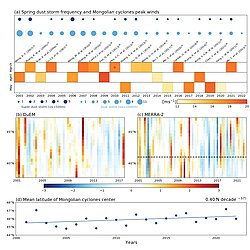
Co-occurrence of Mongolian cyclones and East Asian dust storms in springtime. Show are (a) the number of spring super dust storms and dust storms (including super dust storms) over China and the maximum peak winds of the associated Mongolian cyclone in D2 during individual dust storms as reported by peer-reviewed publications from 2001 to 2022, (b, c) Hovmöller plot of monthly mean dust emission flux anomalies, normalized by the climatological standard deviation, associated with Mongolian cyclones from DuEM (2001–2017) and MERRA-2 (2001–2022) reanalysis, and (d) mean position (latitude) of Mongolian cyclones center per spring and their trends from 2001 to 2022. The occurrences of dust storms are obtained from the China Meteorological Administration measured by in-situ observations of atmospheric visibility across China and validated against past studies addressing the dust storm dynamics. The dust storm event in 2010 is associated with the defined atmospheric depressions with a lifetime of less than 24 h, marked with +. The black dashed line in (c) represents the latitude at 104.5°E and 41°N, located in northern China near the border with Mongolia. (*) in (d) indicates that the statistical significance exceeds the 90% confidence level.
- Februar 2025:
neue Veröffentlichung:
Mu, F., Fiedler, S. How much do atmospheric depressions and Mongolian cyclones contribute to spring dust activities in East Asia?. npj Clim Atmos Sci 8, 51 (2025). doi.org/10.1038/s41612-025-00929-w
Summary:
Severe East Asian dust storms occur in spring due to dust-emitting winds in the Gobi Desert associated with Mongolian cyclones. The present study performs the first quantitative assessment of the contributions of Mongolian cyclones to springtime dust activity in East Asia, based on multiple reanalyses and observational datasets for 2001–2022. Atmospheric depressions dominate dust activities in Northern China, explaining ~90–92% of the total dust emissions in the Gobi Desert and ~88–93% of the dust aerosol optical depth (τ) downwind, depending on the dataset. Mongolian cyclones, defined as long-living and mobile atmospheric depressions, explain almost half (~34–47%) of the Gobi’s total dust emissions and τ downwind, and are the primary driver of high-impact dust storms. The number of Mongolian cyclones, along with the dust activity, has decreased since 2001, with a spatial pattern of the dust emission trend that is consistent with the northward shift of cyclone tracks.
| 2024 News Archive | 2023 News Archive | 2022 News Archive |



